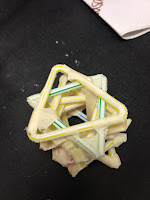 |
| The outer structure. |
Hoping for different results from our previous experiment, our group thought long and hard about what design we could possibly use in order to ensure the survival of our egg. We came up with idea after idea, scrapped them and then did so all over again. Finally, running out of time, we decided to build something that would make the most out of our straws. We decided that it'd be best if we had an outer layer as well as an inner one to give our egg as much protection as possible. Our outer layer was a simple cube (or what was meant to look like a cube).
 |
| Half of the inside structure. |
Our inner layer took a bit more contemplation. Initially, we had just planned to attach the egg from each corner of the cube and secure it in the middle, but remembering that the same design had failed in the first experiment, we were hesitant towards using that method. Although we did still end up attaching the egg in the middle, we did so in a way that the egg was secured by two layers that sandwiched the egg (as shown on the left) and then attached to the cube with multiple straws. By using all these straws to attach the egg to the cube, we could ensure that they all shared the brunt of the impact. This was also a very effective way to securely hold the egg in the middle of our cube.
 |
| Completed structure. |
 |
| Be strong little guy! |
To the left is an image of our completed structure. Since we had a few extra straws we had not used, we decided to cut them up into pieces and use them as legs on each of the corners. Though we knew this wouldn't do too much for the survival of our egg, we decided we could use all the help that we could get.
All that was left was to keep our fingers crossed and hope our egg would survive.
AND THE MOMENT OF TRUTH ...
 |
| Happy to be alive! |







.jpg)